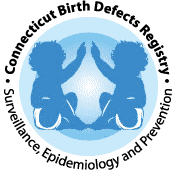
Birth defects are one of the leading causes of infant mortality in Connecticut as they are in the United States. Birth defects are the fifth leading cause of years of potential life lost and a major cause of morbidity and mortality throughout childhood. Although 90% of infants born with birth defects survive their first years of life, some of these children will have life-long disabilities and significant medical and rehabilitation needs.
The mission of the Connecticut Birth Defects Registry is to: 1) maintain statewide Surveillance through collecting information on birth defect incidence in Connecticut; 2) monitor trends and patterns in birth defect statistics; 3) conduct research studies to identify risk factors for birth defects; and 4) promote education activities for the prevention of birth defects.
Birth Defects, as defined by the Centers for Disease Control and Prevention (CDC) Every 4 ½ minutes, a baby is born with a birth defect in the United States. That means nearly 120,000 babies are affected by birth defects each year. Birth defects are structural changes present at birth that can affect almost any part or parts of the body (e.g., heart, brain, foot). They may affect how the body looks, works, or both. Birth defects can vary from mild to severe. The well-being of each child affected with a birth defect depends mostly on which organ or body part is involved and how much it is affected. Depending on the severity of the defect and what body part is affected, the expected lifespan of a person with a birth defect may or may not be affected.
For some birth defects, like fetal alcohol syndrome, we know the cause. But for most birth defects, we don’t know what causes them. For most birth defects, we think they are caused by a complex mix of factors. These factors include our genes (information inherited from our parents), our behaviors, and things in the environment. But, we don’t fully understand how these factors might work together to cause birth defects.
While we still have more work to do, we have learned a lot about birth defects through past research. For example, some things might increase the chances of having a baby with a birth defect, such as:
- Smoking, drinking alcohol, or taking certain “street” drugs during pregnancy.
- Having certain medical conditions, such as being obese or having uncontrolled diabetes before and during pregnancy.
- Taking certain medications, such as isotretinoin (a drug used to treat severe acne).
- Having someone in your family with a birth defect. To learn more about your risk of having a baby with a birth defect, you can talk with a clinical geneticist or a genetic counselor.
- Being an older mother, typically over the age of 34 years.
Having one or more of these risks doesn’t mean you’ll have a pregnancy affected by a birth defect. Also, women can have a baby born with a birth defect even when they don’t have any of these risks. It is important to talk to your doctor about what you can do to lower your risk.
For a full list of birth defects associated ICD 10 codes, click here
Codes:
- Q00-Q07 Congenital malformations of the nervous system
- Q10-Q18 Congenital malformations of eye, ear, face and neck
- Q20-Q28 Congenital malformations of the circulatory system
- Q30-Q34 Congenital malformations of the respiratory system
- Q35-Q37 Cleft lip and cleft palate
- Q38-Q45 Other congenital malformations of the digestive system
- Q50-Q56 Congenital malformations of genital organs
- Q60-Q64 Congenital malformations of the urinary system
- Q65-Q79 Congenital malformations and deformations of the musculoskeletal system
- Q80-Q89 Other congenital malformations
- Q90-Q99 Chromosomal abnormalities, not elsewhere classified
To Learn about Specific Birth Defects: Click Here
The Connecticut Birth Defects Registry collects information on birth defects through various sources of data, including reporting from birth hospitals across the state, vital records, and hospital discharge data. The surveillance activities will provide useful statistical information to health care professionals, researchers, and policy makers. Reporting of birth defects to the Registry is mandatory under the Connecticut State Statutes.
Through its’ birth defect surveillance activities, the Connecticut Birth Defect Registry has developed a surveillance report identifying the prevalence of birth defects in Connecticut from 2018-2020. To access the report, please click here.
There are a multitude of specialty treatment centers, support services, and family advocacy groups available to assist families of a child with a birth defect. The Connecticut Child Development Infoline is the resource of referral services for children with birth defects and other special health care needs. Contact Child Development Infoline at 1-800-505-7000 or click for information on referrals.
Community, Family, and Health Equity Section
Connecticut Birth Defects Registry
410 Capitol Avenue, MS#11MAT
Hartford, CT 06134-0308
Phone: (860)509-8251
Fax: (860) 509-7720

